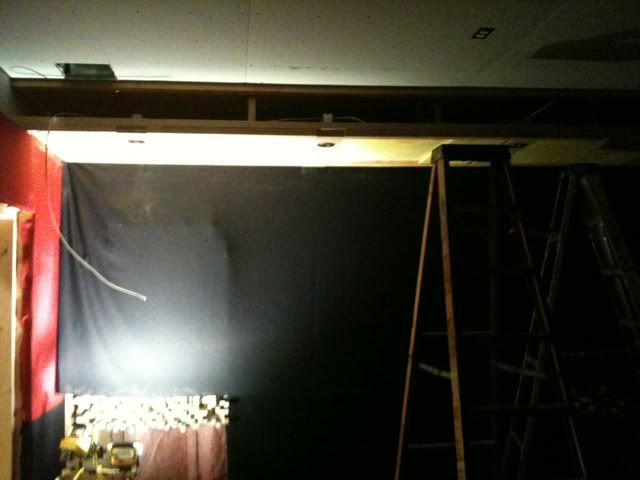Well to be honest, I did not create them to be tuned to a specific frequency.
Panel traps (a.k.a "membrane traps") are always tuned to a specific frequency. They are resonant devices consisting of a known mass mounted resiliently over a known fixed-depth, sealed air cavity, which usually has insulation in it. The surface density of the panel and the depth of the cavity are what determine the frequency. It's a simple mass-spring system: the spring is the air trapped in the cavity, and the mass is the panel itself. The system resonates at a specific frequency, and therefore removes energy from the room whenever that frequency is present. The insulation inside the cavity serves to damp the resonance, and absorb some of that energy. Without insulation, or with very little insulation, it has a very narrow Q, meaning it is tuned sharply to one frequency. The more insulation you put in, the broader the Q gets, meaning that it affects a small range of frequencies around the one it is tuned to, but less effectively. But in your case, the depth is not fixed: since the cavity is a triangular shape, there's no simple way of figuring what is going to happen in there, plus it seems like you didn't mount the wood panel resiliently, so it isn't very effective anyway.
The way that I understood Ethan's panel traps to work were more across a range of frequencies.
As far as I know, Ethan doesn't sell panel traps (membrane traps). He sells bass trap
panels
, yes, but they are not panel traps for bass frequencies. Those are rather different things! I may be wrong, but most of the products that Ethan makes are absorption based, not resonance based. That makes sense, since broadband absorption is what home studios need most! Like I said, I may be wrong but I don't think Ethan makes any tuned resonant devices.
Perhaps I misunderstood his design altogether?!
It looks like you might have!
He had several designs that he labeled "low frequency" ,"low mid", and "High Frequency" absorbers.
That's right! They are ABSORBERS, not tuned resonant devices. Not panel traps / membrane traps.
He never specifically stated which frequencies they were "tuned" for. It was my understanding that they were effective over a range of frequencies not tuned to a specific frequency.
Yup! Because they are broadband absorbers, not tuned resonant devices! Most resonant devices are tuned to very sharply to specific frequencies, and are not broadband. You can't tune absorption to specific frequencies like that. You can make it to cover a
range of frequencies, yes, which is what Ethan does. But he sells panels of absorption, some of which are bass trap, but they are not panel traps. Two different things.
Regardless, I can attest that they are quite effective at smoothing out the low frequency response in my room. I have measured my room's response and am quite pleased with the results.
I'd say that's mostly due to the absorption you have on the rear wall: those "almost hangers" are pretty deep, so they should be doing a reasonable job. They probably act like full width superchunks, or something like that. Your panels are probably helping to keep the highs in the room, since they are reflective, but they might or might not be absorbing energy in the bass range.
I'd really, really suggest that you should download REW and do a full analysis of your room, to see how it is really doing: it might sound good subjectively, but you'll never know what it is actually doing, objectively, unless you test it!

I'd live to see the response and waterfall plots for your room: They should be pretty good, but it would be nice to see them.
I don't know what N7 means?! Please explain.
That's the modulus you choose when you did the calculations for the well depths. Seven is a pretty common choice, and gives good results.
They have a low frequency effective range of 800 cycles and a high frequency effective range of 6700 cycles.
So the low frequency cut off is 800 Hz, they'll still be scattering down to an octave lower, about 400 Hz, meaning that the minimum distance between the diffusers and your head should be about 9 feet, recommended 12 feet or more. From your diagrams, it looks like you should be OK there for the ones on the rear wall, but not the ones on the ceiling. Your head seems to be only about 5 feet from those, whereas the minimum distance for that low cut-off should be 7' 6" (preferably 9' or more), so you are probably in the region where phasing, lobing and timing distortions are an issue. You might want to consider taking those down.
By the way, I love the way you did your speaker soffits! Very solid, very neat, good design, and I'm betting those are very effective. You should be getting a really accurate, tight sound stage with those. And they look great, too! Nice work there! And the lighting also looks pretty cool, all around.
- Stuart -















































